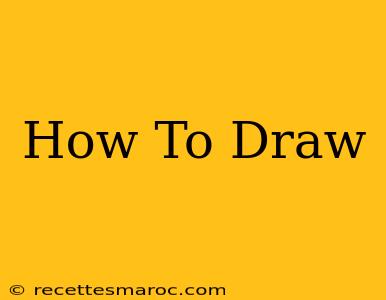So, you want to learn how to draw? That's fantastic! Drawing is a rewarding skill that can bring joy, relaxation, and a powerful way to express yourself. Whether you dream of sketching realistic portraits, creating whimsical cartoons, or simply doodling in your notebook, this guide will provide you with the foundational steps to get started.
Getting Started: Gathering Your Supplies
Before you dive into the creative process, let's gather the necessary tools. You don't need expensive materials to begin; basic supplies will do just fine.
Essential Drawing Supplies:
- Pencils: A variety of pencils is helpful. Start with a HB (medium), a 2B (medium soft), and a 4B (soft) pencil. The number indicates the darkness of the graphite; higher numbers mean darker lines.
- Eraser: A kneaded eraser is highly recommended. It's malleable, allowing you to lift graphite without damaging the paper. A vinyl eraser is also a good addition for removing larger areas.
- Drawing Paper: Use paper specifically designed for drawing. Smooth paper is great for detail work, while textured paper adds visual interest. Look for sketchbooks or pads.
- Sharpener: A sharp pencil is crucial for precise lines. A good quality sharpener will keep your pencils in tip-top condition.
Fundamental Drawing Techniques: Building Your Skills
Now that you've got your supplies, let's explore some fundamental drawing techniques.
1. Basic Shapes and Lines: The Building Blocks of Art
Everything you draw can be broken down into basic shapes: circles, squares, triangles, etc. Practice drawing these shapes repeatedly to improve your hand-eye coordination and line control. Experiment with different line weights (thick and thin lines) to add depth and visual interest.
2. Shading and Value: Adding Depth and Dimension
Shading involves using varying tones of graphite to create the illusion of depth and volume. Start with light shading and gradually build up darker tones. Observe how light falls on objects and try to replicate it on your paper. Learn to use techniques like hatching (parallel lines) and cross-hatching (overlapping lines) to create different values.
3. Perspective: Creating Realistic Scenes
Perspective gives your drawings a sense of space and depth. One-point perspective uses a single vanishing point on the horizon line, while two-point perspective uses two vanishing points. Start by practicing these basic perspectives, and gradually incorporate them into more complex drawings.
4. Practice Makes Perfect: Consistent Effort is Key
The key to improving your drawing skills is consistent practice. Set aside some time each day, even if it's just for 15-20 minutes, to draw. Don't be afraid to experiment, make mistakes, and learn from them.
Finding Inspiration and Expanding Your Skills
Learning to draw is a journey, not a destination. There are many resources available to help you along the way.
Resources to Enhance Your Learning:
- Online Tutorials: YouTube is a treasure trove of drawing tutorials for all skill levels.
- Drawing Books: Numerous books offer comprehensive instruction on various drawing techniques.
- Online Courses: Websites and platforms offer structured drawing courses with expert guidance.
- Drawing Communities: Join online forums or local art groups to connect with other artists, share your work, and receive feedback.
Embrace the Process and Have Fun!
Remember, drawing is a process of continuous learning and improvement. Don't get discouraged if your early attempts aren't perfect. The most important thing is to enjoy the process, experiment with different techniques, and express your creativity. So grab your pencils, find a comfortable spot, and start drawing! You might be surprised at what you can create.

